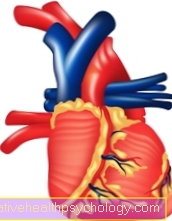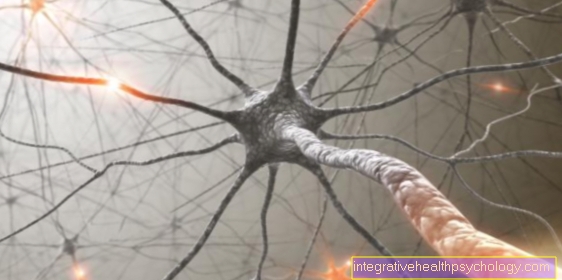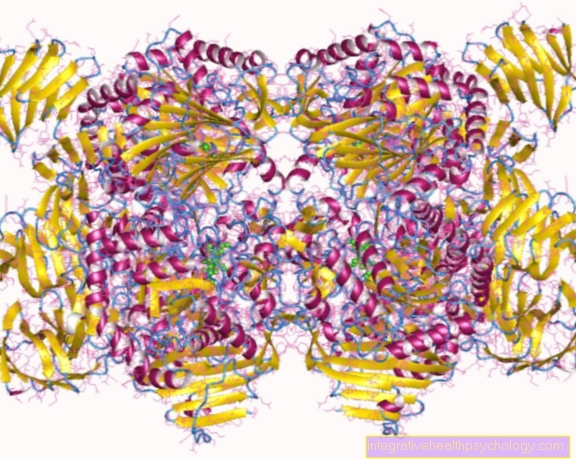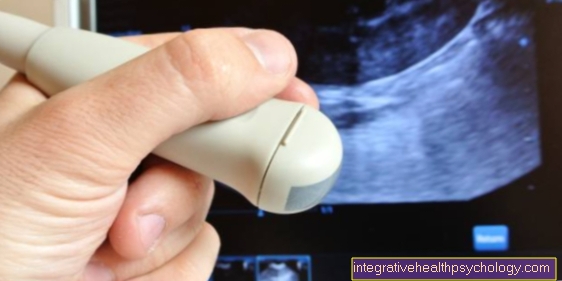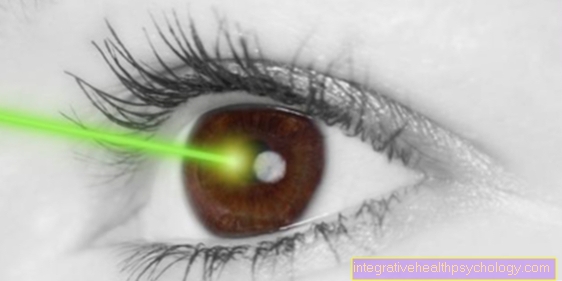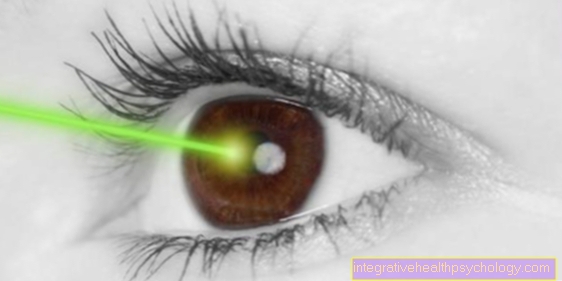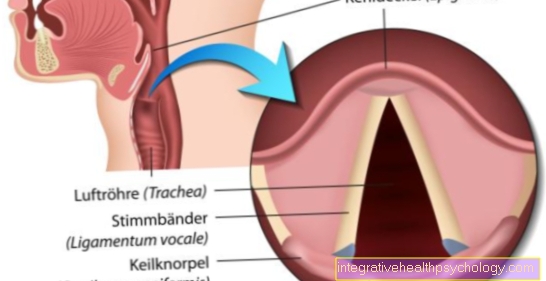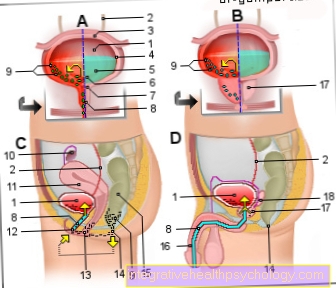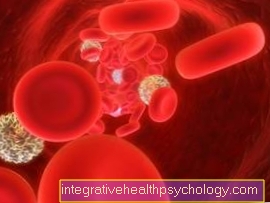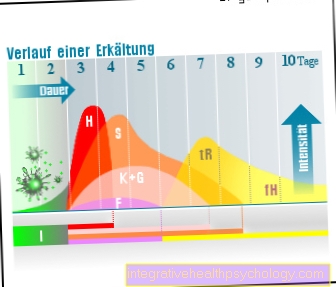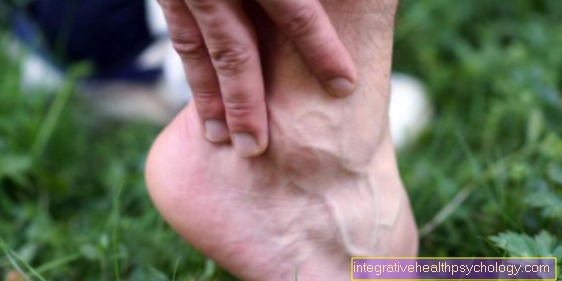Locked-in Syndrome
introduction
The term Locked-in Syndrome comes from the English word "locked in" and means to lock in or lock up.
The meaning comes from the situation in which the patient finds himself. He is awake and can understand and follow conversations, but cannot move or speak.
Often there are just one vertical eye movement and the Eyelid closure possible - the patient is virtually locked in his own body without being able to move.

The locked-in syndrome is caused by a very special brain damage caused. The clinical picture goes with it severe paralysis which can affect all arbitrarily controllable muscles in the body. The Sensation of touch can remain completely untouched.
The locked-in syndrome means enormous suffering for the patient and also for his relatives. It is in contrast to the apallic syndrome, the so-called Vegetative state. This is another severe type of brain damage, in which, however, no reactions from the patient to various stimuli are to be expected. The patient is not aware of his environment.
causes
The Locked-in Syndrome caused by damage to the Brain stem, more precisely due to a defect in the front Pons ("Bridge").
Almost all of the nerve tracts that control the nervous system run in this area arbitrary movement are responsible. An exception is the nerve tract, which coordinates the vertical eye movements, which is why these are often the only means of communication.
In most cases, the cause of the brain damage is the Closure of a main supply artery to the brain (Basilar artery), for example as part of a thrombosis. Due to the closure, the region is no longer supplied with oxygen, which very quickly leads to cell death (death) in nerve cells.
Another possibility is the so-called central pontine myelinolysis. This is the death of central parts of the pons, which for example by a severe sodium deficiency can be triggered. The deficiency in itself is not the dangerous one, but the therapy. If the deficiency is compensated too quickly, the corresponding reaction occurs.
Other causes are extensive damage to the pons through accidental (traumatic) changes or local inflammatory diseases.
Symptoms
The symptoms that the Locked-in Syndrome occur, limit the patient's life in the most massive way. It is not possible for those affected to control their voluntary muscles.
It is not just them who are affected by paralysis Limbs, the back, the chest and the abdomen, but also the neck, throat and face muscles.
Neither speaking nor swallowing are actively possible. The patient therefore usually has to be fed artificially.
Almost all Eye muscles are also affected by the paralysis, it's just one vertical eye movement possible which as Communication possibility can be used.
The patient is not at all or barely restricted in thinking and consciousness and fully perceives his environment. For those affected, this means a lot of suffering because, although they are fully aware of their environment, they cannot interact with it.
The patient is helplessly exposed to the situation. From this state are psychiatric secondary diseases, such as depressions, No rarity.
therapy
An improvement of the symptoms is possible through intensive supervision and comprehensive care measures.
First, the cause of the brain damage must be largely eliminated. Then, to a large extent, one must trust the brain's ability to reconnect nerve cells and thus restore the functionality of various nerve cords.
The different therapists have to work closely together. Speech therapists practice speaking with the patient, Physiotherapists try to maintain mobility and slowly enable your own movements. The extensive therapy concept that is used in locked-in syndrome to improve the condition of the disease also includes Psychotherapy and occupational therapy.
With a lot of patience and work, a far-reaching regression of the symptoms is possible, but cannot be promised. It exists so far no drug or surgical therapy option.
maintenance
Caring for someone with locked-in syndrome is extremely time-consuming. Due to the holistic paralysis, everyone has to at least at the beginning of his recovery phase Hygiene measures be taken over. Since it is not possible to go to the toilet normally and it is not possible to press a button, diaper care is usually started, which can be replaced by a bedpan during the healing process.
Through the Paralysis of the pharynx and throat muscles further problems arise in the care. The patient has lost the ability to speak and therefore cannot communicate any needs. The Communication takes place only through eye movementwhich requires a lot of patience on the part of the nursing staff. Understanding the patient's language is a laborious process that requires a lot of empathy.
The swallowing muscles are also paralyzed, which is why one at the beginning artificial nutrition must be sought. This can be ensured either via a nasogastric tube or via infusions.
Feeding via a gastric tube has the advantage that the gastrointestinal tract can continue to function and the risk of additional illness is reduced.
forecast
The prognosis for an existing locked-in syndrome is generally poor. It is a serious disease of the nervous system, which is extremely sensitive and slow to heal.
The symptoms can only improve after weeks or months use what requires the patience of the patient, the relatives and the treating staff.
An improvement in the symptoms is possible through intensive treatment measures, but a complete cure is unlikely. In most cases, residual symptoms remain and patients learn to live with. Language skills in particular have good regression tendencies.
The death rate is significantly higher in locked-in patients, which is due, among other things, to secondary diseases that are related to immobility.
cure
Locked-in syndrome is unlikely to be completely cured.
An improvement in the symptoms can be achieved through complex and, above all, lengthy therapeutic measures.
In contrast to the Vegetative state however, the chance of near healing is better. The patients who have been in the locked-in syndrome for a long time experience this Regaining the ability to speak and swallow already a clear healing success, as these skills mean a big step towards independence. The healing process takes a very long time and should be combined with a gradual reintegration into professional and, above all, social life.








